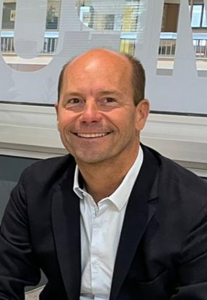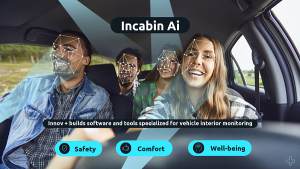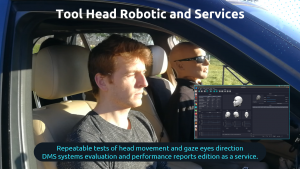[ad_1]
A pioneer on the French Driver Monitoring System (DMS) market, the young innovative company INNOV+ began its innovation journey in 2014. It has since come a long way and diversified its activities, always with development in mind. innovative solutions serving driver safety and comfort, largely based on AI algorithms.
Previously hosted in Gif-sur-Yvette in the premises of Centrale SupElec, INNOV+ moved on November 30 a few hundred meters away, to the premises of the Ferme du Moulon. With a dozen full-time employees, the company achieves a turnover close to a million euros thanks to the AI solutions it develops for driver safety, but also for consulting missions. which it carries out at the request of manufacturers and equipment manufacturers. To accelerate its development, INNOV+ recently launched a series A fundraising campaign for an amount of €5 million, which it hopes to see completed by the end of this first quarter of 2024.
At the beginning of January, the company presented to global equipment manufacturers, at CES in Las Vegas, its latest innovations, and in particular its “robotic head” allowing it to reproduce the head and eye movements of a driver. Stéphane Arnoux, co-founder and CEO of INNOV+, tells us more about this new feature, but also about all the advances made by the company since its creation in 2014, as well as its current projects.
Engineering Techniques: You co-founded INNOV+ with Patrice Lacroix in 2014. How did you meet, and how did this entrepreneurial adventure begin for you?

Stéphane Arnoux : The meeting took place a long time ago…! We actually grew up at school together, from middle school to baccalaureate, and even up to a course in electronics at Bac+2. I then went to business school, and my partner continued his studies in electronics. We lost touch for about fifteen years. However, we ended up meeting again around our thirties during the Motor Show: Patrice managed the access controls for the event, and I was present there due to my professional duties. within a Bosch subsidiary.
We both began to work together, then decided, when we turned forty, to start a business together. Our profiles seemed very complementary to us, Patrice with his “tech” skills and me with my “business” profile.
Our ambition, with INNOV+, was to create innovative software, in a field that was historically mine: that of the automobile. Very quickly, we started building prototypes on Android, while realizing the potential interest of optical sensors for sleep detection. We thus made a strategic pivot, and INNOV+ became a start-up in 2014.
Who accompanied you in this shift that you decided to make? What were the next steps?
We benefited from an incubation phase at IncubAlliance[1]. We are also surrounded by the expert skills of SupOptique[2] in order to design a specific optical sensor, operating in the near infrared to allow us to analyze the eyes of drivers behind sunglasses or even at night. At the same time, we embarked on the development of an algorithm for tracking head movements and eye rhythm, with the aim of detecting microsleeps, but also distractions. This is to be able to broadcast visual and audible alerts in the passenger compartment of a vehicle in the event of drowsiness or inattention on the part of the driver. For six years, we combined hard- and software development, in order to achieve our proof of concept. We then experimented with this POC on Transdev coaches, on Total trucks, or even utility vehicles from Enedis, GRTGaz, Vinci and Bouygues.

We finally came up with two versions of hardware and also created the Toucango brand, in order to offer a traveling companion to drivers.
We also tried to industrialize the technology to the level hardware, just before the health crisis. COVID was unfortunately a barrier to the “go to market” that we intended to achieve for vehicle fleets. However, we have already been working since 2015 for PSA, now Stellantis, on the integration of this sensor type in the dashboards, in order to make it a Driver Monitoring System (DMS), in line with ADAS (Advanced Driver Assistance System). This new type of system was made compulsory by the EU in 2019, for all vehicles registered from 2025.
How does this type of system work?
A DMS first includes a near-infrared camera, equipped with LEDs responsible for illuminating the scene, night and day in order to more easily follow eye rhythm and head dynamics. This camera module is placed in the axis of the steering wheel and connected to the vehicle’s ADAS computer. This calculator is equipped with software responsible for analyzing the dynamics of the gaze and face, what we call the gaze[3]. This is how the DMS is able to detect distractions or microsleeps which are the beginnings of drowsiness. The software characterizes these alerts and sends the information to the computer. It is then up to him, depending on the programming made by the manufacturer, to send audible and visual alerts, or even vibrations in the seats.
The software chain has evolved significantly in recent years as the resolution of optical sensors has improved. Regarding image processing, we initially processed faces in two dimensions. Today we manage to reproduce a head in 3D, thanks toEmbedded AImore precisely neural networks of the type HOWEVER et CNN. This allows us, for example, to reconstruct an eye hidden behind glasses, or a face half-hidden in shadow, and therefore in fine to improve our predictions of sleepiness and distractions.

This DMS thus brings a first camera into the passenger compartment of the vehicle, but many others should follow, to monitor or offer more comfort to occupants, in the form of OMS, for “Occupant monitoring systems”, or even d IMS: “Interior monitoring systems”.
Who are your customers today? What are your plans for the months and years to come?
Since the COVID crisis, we have played the role of “coach”, validation and integration partner for Stellantis and its sensor manufacturer and software developer, Forvia. We advise them on the location of the cameras, the choice of their quality, as well as that of the software which then processes the signal from these optical sensors.
To do this, we have developed a robotic head, which can reproduce the head and eye movements of a driver behind the wheel. It can also be equipped with glasses, in order to study reflection phenomena which disrupt image analysis.
We deliver a report to our customers at the end of the test phases that we carry out over a period of two weeks, which points out possible weaknesses in the system, in order to then enable them to improve its operation.
The share of vehicles equipped with a DMS today in Europe is around 10%. The market will develop thanks to the legislative developments that I mentioned. In particular, we have five or six Stellantis vehicle models to test in the coming months. Our own AI algorithms are not yet on board the vehicles of our customers, who have opted for the solution of Swedish counterparts. On the other hand, we are actively preparing the integration of our software, this time in the aeronautical field, with the help of the DGAC. To do this, we are going to transpose the Toucango AI into an aircraft environment, with a two-camera system: one for the pilot, the other for his co-pilot.
We are also continuing to deploy Toucango in small steps, to customers who have specific needs. This represents between one hundred and two hundred vehicles per year, mainly French-speaking fleets, or vehicles used on mining sites in Africa, where safety is essential. Even if we have not really been able to industrialize the solution, 700 to 800 vehicles around the world are today secured thanks to our Toucango solution. We provide sleepiness and distraction reports to our customers every month. It also serves as a laboratory for us to improve our software.
Furthermore, we have not yet explored the path of biometrics, but I think we will get there one day… This could indeed bring many interesting features, such as automatic memorization of the position of the seats. We are not necessarily the most advanced in this area, compared to the Chinese for example, but we have the advantage of a protective regulatory environment, able to prevent possible abuses of AI and technology. computer vision.
We are also moving forward on two other strong areas of development. The first aims to develop ever more useful in-cabin monitoring software. Our ambition is to develop a real time video cleaner system intended to provide manufacturers with homogeneous images, of the best possible quality, in order to facilitate decision-making by calculators. We also aim to develop an “eye cleaner”, an algorithm which aims to erase the driver’s glasses, whether it is the frame or the reflection of the lenses. For this, we are supported by Bpifrance, and hope to produce a first version in the coming months. This software brick, which promises to be quite disruptive, will be able to be offered to the market, we hope, during 2024.
On the other hand, we create a room that we call the lighting room. It should see the light of day at the start of 2024 in our new premises. This is a room equipped with a turntable, on which a vehicle can be placed. A lighting strip reproduces the movement and intensity of the sun in the form of an ellipse. This will allow us to test the cameras of our customers’ vehicles in lighting conditions comparable to those encountered throughout the day, and this on different types of faces, as well as on our robotic head equipped with different types of glasses.
To test the cameras in its customers’ vehicles, INNOV+ is currently developing a room equipped with a turntable and a lighting strip reproducing the elliptical trajectory of the sun as well as its variations in light intensity.
[1] Paris-Saclay deeptech incubator, created in 2000.
[2] Institute of Optics – Graduate School of Paris-Saclay
[3] In English, “fixed gaze”, literally.
[ad_2]
Source link